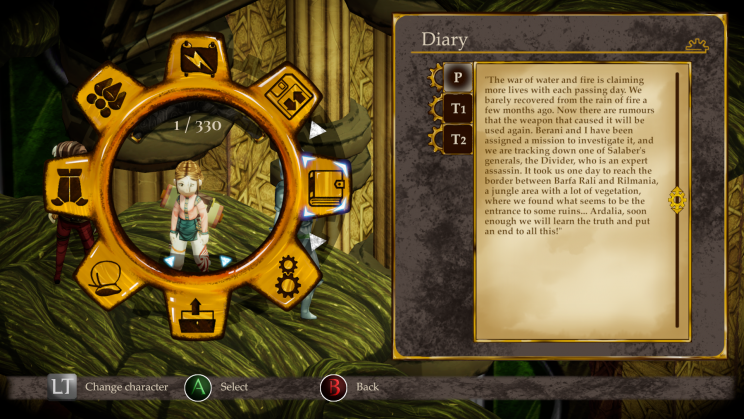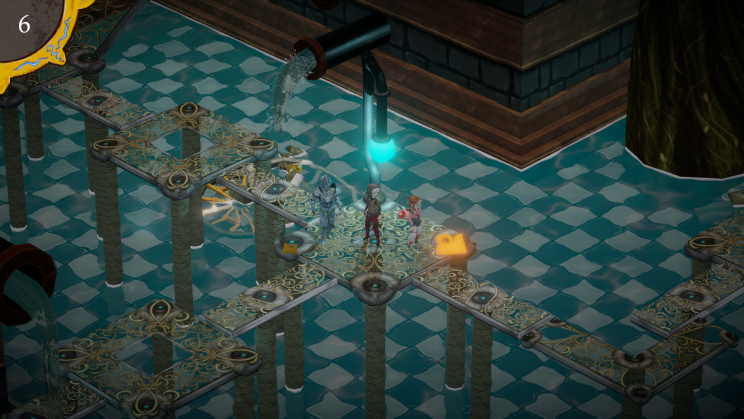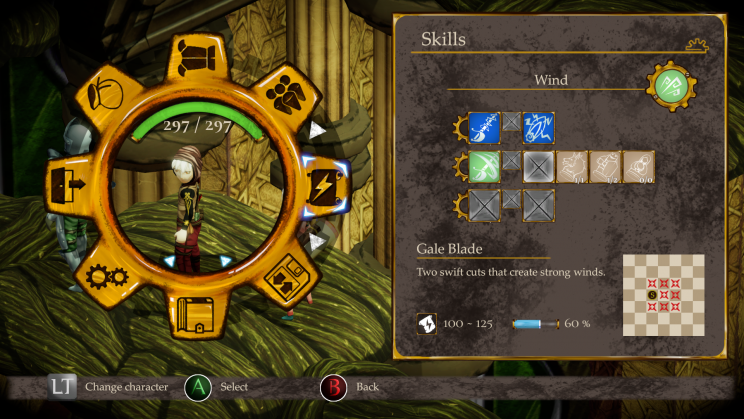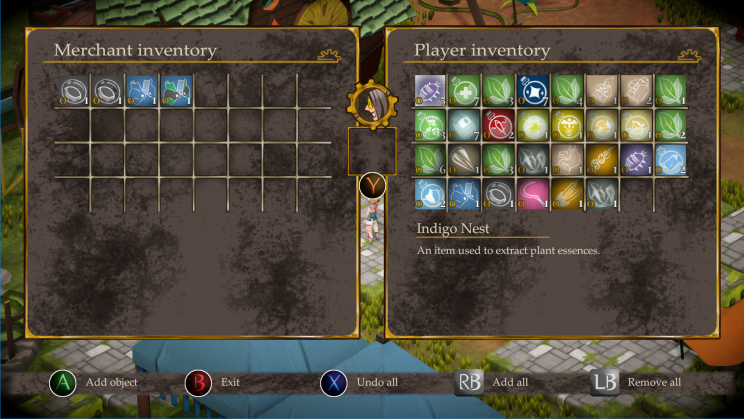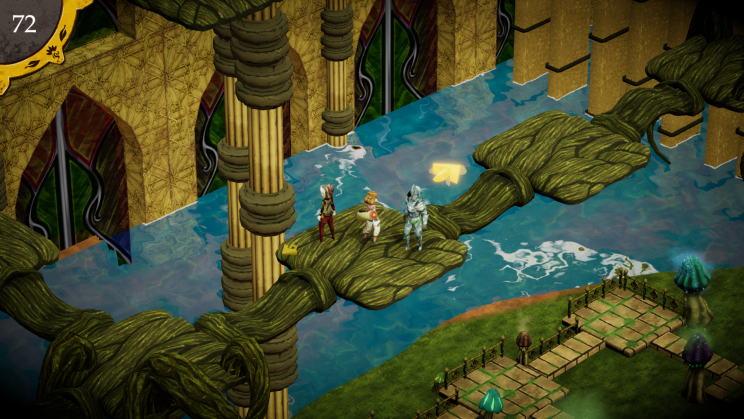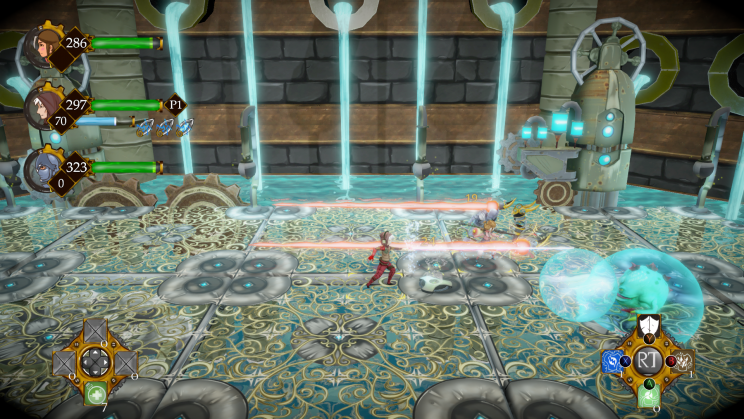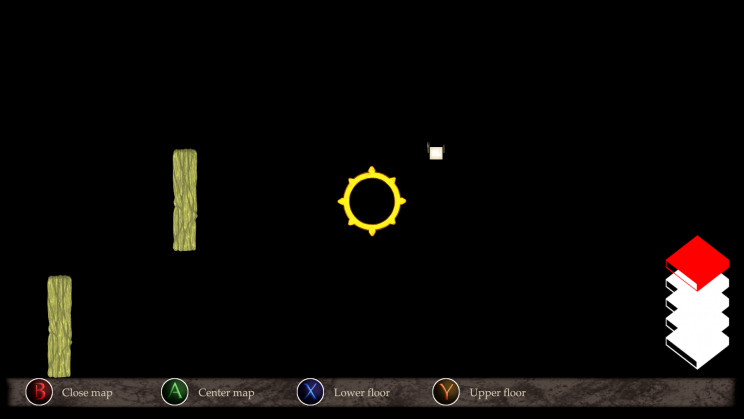Noahmund is a new JRPG and the first game produced by Estudio Ábrego, available on Steam for $20 (okay, $19.99, but that penny isn’t fooling anyone). With clear roots in the jRPG tradition, Noahmund looks to make its mark with fresh new takes on exploration and combat while telling a grand story centered around deep characters as you follow the story of Galina, a new agent of Shinn; Berani, her guardian; and Stalos, a mysterious figure. On a mission to investigate rumors of a devastating super-weapon, Galina and Berani encounter Stalos and are dragged into an adventure revealing just how little they understand about their world and the dangers it faces. Explore large dungeons and face powerful enemies in the game’s unique Action Battle Chess system where you need quick thinking and solid tactics to make the most of your abilities.
Noahmund is the first product of the indie group Estudio Ábrego, so keep in mind that we’re not expecting AAA-level graphics and design. However, it is on Steam as a finished product, so this evaluation does expect a certain level of polish.
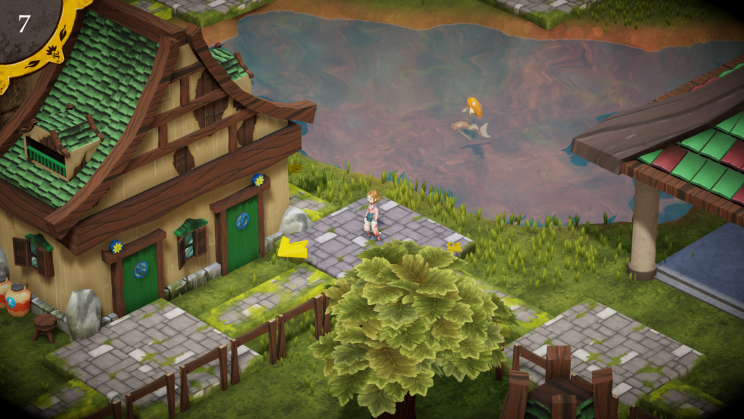
The starting town is very charming, albeit a bit easy to get lost in. Oh, and the wells are a teleportation network.
Technical Issues
There are a couple technical problems that warrant mention before we dive into the game proper. First, the game supports both keyboard and controller, but having a controller plugged in blocks keyboard input entirely. The screen resolution settings are very limited, and if you have a wider screen than usual, such as my UW curved monitor, I strongly suggest you just play in windowed mode. In fullscreen or borderless fullscreen, you play with the familiar black spaces on either side, but alt-tabbing out causes the graphics to get stretched to fill the full width of the screen, which chops off the top and bottom of the view in the process. This requires going into the display settings and changing anything to get the display to reset.
Story
If you are an avid fan of jRPGs, cRPGs, aRPGs, and just RPGs in general, as I am, you probably look for a great story and compelling characters as main selling points. Estudio Ábrego definitely had this in mind while creating Noahmund, and the story, once you get into it, is both interesting and expansive. The world is one they have obviously built up and have clear ideas of the history, culture, technology, and more for numerous areas in the world. The main characters are all well-crafted with solid backstories, clear personalities, and the occasional quirk thrown in for humor. Even some of the side characters are developed well enough to make clear they have their own unique traits rather than just being exposition placeholders. There are two main problems I ran into, however.
The first is that NPCs being more than exposition placeholders should not mean getting rid of the exposition. I understand it is a very difficult task to introduce a new world with loads of unique places, people, and concepts without turning it into an exposition dump, but Noahmund ends up sliding too far the other way. In the first half-hour, roughly a dozen names come up in various discussions without any explanation of who, what, or where any of them are, or even whether the name is a person, place, or thing in some cases. Core concepts of the world are mentioned as though everyone in the scene knows their details and history, but players are left largely in the dark. It’s one thing to say “We’re still learning exactly what Synchrony is and how it works, but here’s what we do know…” as a way of introducing the concept and letting players know they will be finding out more about it as the game goes on. Instead, we get a combat tutorial (in name, at least) that tells players what keys to press to use something called Synchrony, and then things go on as if we should already know exactly what it is. Synchrony is obviously a big deal in the world and story, but that is not conveyed in the early storytelling of the game.
Likewise, the setting involves a huge war that has been raging for years, but we get almost zero information about the war. Who is fighting? North and south, fire and water, something like that; nobody can be bothered to explain the sides beyond a couple of off-hand tidbits like that. I don’t even know if the two sides are nations, groups of nations, or something else entirely. Are the two sides most of the known world, just a pair of small-time enemies, or something in between? No clue. There are definitely some aspects of the world that is supposed to be slowly-revealed secrets, but players just don’t get enough basic information to understand the state of the world as seen by Galina and Berani to follow their discoveries.
The second major story issue is the translation from the game’s original Spanish. Some of the translation work is actually quite good, but some places are poorly translated, and some are not translated at all. The opening sequence is delivered in Spanish and has no subtitles even with English subtitles turned on in the menu. Trying to save your settings in the menu displays a prompt reading “Video settings will be restored to default settings. Proceed?” (choosing Yes does in fact save your settings). There are instances of the wrong name and face being shown when a character is talking. Typos such as misspelled words are far too common, and sometimes there are multiple inconsistent versions of terms and phrases (such as “Orb of Unlocking” and “Orb of Opening” or “the Divider” and “the Divisor”). These things all serve to pull players out of the story and give the game an unpolished impression that may reduce the fun players can have.
Aside from the two major issues, there are some plot holes and clichés in the storytelling itself, but that’s par for the course in an RPG. The only glaring one, to me, is why a novice agent and her not-exactly-professional guardian, both young and inexperienced, are sent to follow the supposed big bad, who is a general of an enemy army and is referred to as “a master assassin”. What exactly was the Master thinking when he decided that?
Graphics
The graphics consist of cutscenes with drawn art and minimal movement and gameplay with full 3D assets. The quality of both is not going to win any awards, but it is perfectly acceptable for a small indie developer. Character models are stylized and have a bit of the bobble-head look to them, which works well for the game. Environments are surprisingly detailed, very colorful, and overall quite pleasant to just wander around in. In combat, the same character models are used and enemies have a similar stylized aesthetic, but the effects for various attacks are well done and look great. Naturally, any system that might have trouble running Noahmund will likely have trouble running Steam to get it anyway.
Sound
The music for the game is excellent and distinctly better than even plenty of AAA games. Lots of indie games offer OSTs for reasons I’ve never understood, but this one is actually worth considering. The quality of sounds effects and environmental factors like water are all solid as well. There does not appear to be any voice-acting aside from the narration over some cutscenes, but that’s neither surprising nor a problem for a studio this size.
Gameplay
Tutorials
The only tutorials are very brief, scripted fights where players are told what buttons to press to use new abilities. These really don’t do a very good job of preparing players as tons of important information are skipped entirely, and some of the information given is simply wrong (possibly a translation issue, but I did notice they have changed the combat system since some of the older screenshots). For example, players are told charging Galina’s Synchrony power too much will cause you to lose energy, but this does not appear to happen. More importantly, the charge gauge is not pointed out and players are *not* told that it is the petals (their number, specifically) that appear on the gauge each time it fully charges that determines the power of Galina’s abilities. Players are also not told that different charge buttons charge for specific allies in combat, and each ally has their own gauge+petals, though abilities affect all allies at the same time. When you gain offensive Synchrony, it is not mentioned that the dark, glowy orbs appearing over an enemy when you hit them are like the petals except for offensive abilities. Whether all abilities always consume all petals/orbs (the first two do) is also unexplained. The combat mechanics of Berani and Stalos (each character has completely different combat abilities) are likewise left mostly unexplained.
There are also no tutorials or explanations of most out-of-combat game mechanics. Most interactions are indicated with fairly clear (though never explained) icons, but there are plenty of NPCs who will talk to you without having the conversation prompt. Early on, players are directed to take some herbs to an alchemist to be made into potions. What you are not told is that this is your introduction to the shop system, that you will have to “pay” for the potions, that you can choose whatever potions you can “afford”, and that I put quotes around pay and afford because the shops actually work off a barter system. I’m not a big fan of barter economies in games because they are almost always just needless layers of complication on top of a system where everything has a set money value anyway. Effective prices are set and never fluctuate like a real barter economy would. That said, I would not count it against Ábrego just for doing that. What I do dislike is the lack of explanation of the system and the facts that players do not get to view an item’s stats or effect before buying it and cannot see the relative values of items (such as several types of ore you collect).
Exploration
Noahmund uses a unique grid-based system for exploring dungeons, towns, etc. Players move between nodes, and each move also lets enemies on the map move one space as well. There can be quite a bit of variation in distance covered by one move, though it is not always obvious whether the next nod is ten feet down a hall or all the way at the far end. The maps themselves are fairly well laid out with lots of offshoots to explore, vertical shifts and layers, and actions to take in various places that open up new routes in others. That said, movement is a bit aggravating because there is a delay between each move as the characters arrive, and players must press a direction and hit a key for each and every move (so players cannot simply continue down a path through several nodes by holding a direction). This makes the constant retracing and backtracking a little more onerous than it needs to be. I have also found a couple places where the pathing used to control your characters moving from one node to another does some ridiculous things like running a long way around a loop instead of just stepping ten feet forward to get to the next node. Finally, there is a map of the town or dungeon you are in, but the dungeon one is rarely useful to me. It is rotated 45 degrees off from the actual environment, only fills in nodes you step on (there are frequent square loops with nothing but an enemy in them), frequently has holes that refuse to fill in, and often does not indicate important information such as layer transitions or map transitions.
Combat
If you can get past the lack of information, combat is really where Noahmund shines. It uses a system called Action Chess Combat where everyone moves on a square grid and can make attacks in the four cardinal directions. The system is engaging and tactical, rewarding both planning ahead of combat in setting up your abilities and careful positioning in combat to make the best use of those abilities. Each character has a completely different style in combat, and all of them are fun to play directly. Galina charges up various healing abilities for allies and debilitating effects for enemies, Berani charges in with stances and direct attacks, and Stalos uses elemental mines and indirect attacks. While players only control one character at a time, the AI that controls any other characters is surprisingly decent and responsive to the functions of the characters. Galina will move away from enemies and heal when anybody gets low, and Stalos will plant his traps in decent locations. Enemies have similar AI and follow certain patterns and tells specific to each enemy type, so players can learn better tactics against each enemy. Each character has several abilities that can be further modified into three alternate forms by attaching special chess pieces found around the world.
I have two complaints with the combat, aside from the lack of explanation of critical information. First, movement can feel clunky and unresponsive at times, causing me to occasionally move in a direction I do not want to because direction input is locked in a moment before it actually happens. This is less of an issue with characters that have higher Speed stats since their movement cycle is faster, but it is still noticeable from time to time. Second, while normal attacks are easy to launch in all four directions, ability direction is more finicky. Trying to run away from an enemy and turn to launch an ability involves either moving back toward the enemy or wasting time making a basic attack toward them in order to turn the character that way. Otherwise, the ability blasts off the wrong direction. There is also a problem with Berani’s first ability where the descriptions on the first and second alterations are switched.
Those gripes aside, I really do enjoy the combat in Noahmund. Swapping in different abilities (changed by attaching the chess pieces) can dramatically change how a character plays in combat, and it is fun finding the combinations that work best for you on each character. Enemies themselves are varied enough to usually keep things interesting, and new combinations of enemies can often give battles very different dynamics. Players can only equip four consumable items to take into combat as well, lending an extra layer of strategy in trying to anticipate whether you will need this or that restorative or can you instead bring a stat-booster.
Misc
Noahmund is an RPG in the jRPG tradition, so there are naturally items to use and gear to equip, though it would be really nice if we could see the exact effects or stats of something before committing to buying it. The array of items is quite broad, though status restoring items are compressed down to a few items that each cure a group of statuses (since there is a hard limit on consumables in combat). With regards to gear, each character has a weapon, armor, and an accessory, and the first two are specific to that character. It is possible that the selection opens up more later, but I found the options for each character to be very scarce and more of the direct upgrade type than giving any strategic choice here.
The Verdict
I really want to recommend Noahmund. The combat is interesting, the story looks to get stronger as you go, and it has a charming look and feel. But… I just can’t. If it was just translation issues and even the lack of exposition, I could overlook those, but there is a whole laundry list of problems. In addition to the dozens of minor glitches and bugs, the dungeon map is flatly broken, core game concepts receive little or no explanation, and not being able to see the stats of an item before buying it is inexcusable. This is supposed to be a full release, and I cannot recommend it on that basis. That said, it has the potential to be a solid game, and I hope it will get there eventually. If Estudio Ábrego plans to fix most of these issues, I would love to change my verdict on it once they do.
